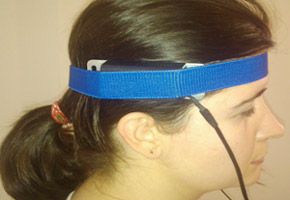

Instruments developed in the study are in the patenting and registry phase for sale
Instruments developed in the study are in the patenting and registry phase for sale.
Instruments developed in the study are in the patenting and registry phase for sale.

Instruments developed in the study are in the patenting and registry phase for sale
By Elton Alisson
Agência FAPESP – More than two centuries ago, a dogma endured in medicine known as the Monro-Kellie doctrine. It said that the cranium is a rigid, inextensible bone structure. Over the last five years, researchers from the Physics Institute at the Universidade de São Paulo (USP) in São Carlos began to break down this paradigm, which was established in 1783.
These researchers proved that an increase or decrease in intracranial pressure causes linear volumetric variations on the skull. They also proved that due to this slight elasticity in the bone structure, measuring internal cerebral pressure in patients with hydrocephalus, cranial trauma or tumors would be possible without having to perforate the cranium, as is standard procedure today.
The scientists started a company to demonstrate this technique, and in a project funded through FAPESP’s Innovative Research in Small Companies project, developed a simple and minimally invasive method.
Conceived by professor Sergio Mascarenhas, founder and ex-coordinator of the USP São Carlos Advanced Studies Institute (IEA), the equipment now has two new versions.
“We started the project with a minimally invasive method, and through the research we’ve done over the last five years, we managed to develop two more non-invasive instruments in recent months,” said Gustavo Henrique Frigieri Vilela, researcher at the company Sapra Assessoria, funded by PIPE, to Agência FAPESP.
According to Vilela, monitoring intracranial pressure with the first instrument they developed required shaving the patient’s hair and making a small incision on the head so that a sensor could be glued to the cranium to register bone deformation, which is proportional to intracranial pressure.
With the new equipment, however, even cutting the patient’s hair is unnecessary. “Just placing the sensor on the scalp is enough to do the monitoring,” Vilela affirmed.
The first new version of the equipment, which may be used in clinics and outpatient care centers, is a system that is placed on the patient’s head to measure the deformation of the cranium.
The second version, called the Brain Strap, is a 10-centimeter-wide strip that is placed around the patient’s head. The patient can move around or even take part in physical activity while being monitored.
Vilela says the two new instruments are just as sensitive as the instrument that was used with the minimally invasive method and will be patented in the United States and some European nations through FAPESP funding.
The three instruments are in the process of registration with Anvisa (the National Health Surveillance Agency) and will later be certified with the Food and Drug Administration in the United States and the European Community so they can be sold.
“We perfected the prototypes, then patented them, and are now registering them so we can put them on the market,” said Vilela.
Articles and a new company
The minimally invasive equipment was tested on brain trauma patients at the USP Riberão Preto Medical School’s Hospital. Subsequently, the equipment was tested for many other applications, such as the diagnosis and monitoring of stroke patients, as stroke increases the internal volume of the brain and intracranial pressure. It was also tested for the diagnosis of brain death, when intracranial pressure disappears, and for the diagnosis of epilepsy.
Other possible applications for the equipment are in pharmacology, for measuring the effects of drugs that cause chemical imbalances in the brain and alter intracranial pressure—such as migraines—and in veterinary medicine, to measure the intracranial pressure of large animals such as cattle and pigs when testing for encephalitis, or swelling of the brain, which increases intracranial pressure.
Comparing the data generated by the equipment with that obtained from the invasive methods used to monitor intracranial pressure in initial clinical studies today, Vilela says the instruments created by his team give better results. The minimally invasive method was also able to capture the respiration and heartbeat of the patients.
“The instrument isn’t just a clinical monitor, but is now multi-paramedic, as it can measure intracranial pressure, and cardiac and respiratory frequencies,” he affirmed.
The Brazilian researchers will publish a chapter in February’s Acta Neurochirurgica Supplementum, where they will demonstrate through the method they developed that the Monro-Kellie doctrine is no longer valid.
The book is titled Intracranial Pressure and Brain Monitoring XIV, and it will bring together 80 research articles presented at the 14th International Symposium on Intracranial Pressure and Brain Monitoring held in Tubingen, Germany, in September 2010.
The researchers will publish another article in the International Journal of Mechatronics and Manufacturing Systems in March, wherein they will describe the use of the new equipment and the minimally invasive method for monitoring intracranial pressure in neurosurgery and neurophysiology.
“Our project grew more than we imagined it would at the beginning. We are now registering a new company, called Brain Care, for the commercialization of the equipment for neurological application,” said Vilela.
The article “The New ICP Minimally Invasive Method Shows that the Monro-Kellie Doctrine Is Not Valid” by Vilela and others can be read in Acta Neurochirurgica Supplementum, which may be accessed at: www.springer.com/medicine/surgery/book/978-3-7091-0955-7.
Republish
The Agency FAPESP licenses news via Creative Commons (CC-BY-NC-ND) so that they can be republished free of charge and in a simple way by other digital or printed vehicles. Agência FAPESP must be credited as the source of the content being republished and the name of the reporter (if any) must be attributed. Using the HMTL button below allows compliance with these rules, detailed in Digital Republishing Policy FAPESP.





